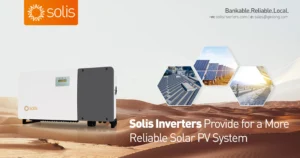Solis inverters are widely used in the solar industry to convert the direct current (DC) generated by solar panels into alternating current (AC) that can be used to power homes and businesses. However, like any electronic device, Solis inverters can sometimes encounter issues that may disrupt their normal operation.
In this ultimate Solis inverter troubleshooting guide, we will discuss common problems that can arise with Solis inverters and provide step-by-step solutions to fix these issues easily.

Understanding the Basics of Solis Inverters
Before we dive into troubleshooting Solis inverters, it’s essential to familiarize yourself with the basics of how these inverters work. Solis inverters are designed to optimize the power output of solar panels by converting the DC electricity they produce into AC electricity that can be used to power appliances and devices.
Solis inverters are equipped with advanced features such as maximum power point tracking (MPPT) and reactive power control to ensure the efficient conversion of solar energy. They also incorporate safety mechanisms such as anti-islanding protection and ground fault detection to protect against electrical hazards.
Identifying Common Problems with Solis Inverters
Solis inverters are generally reliable, but they can experience certain issues that may require troubleshooting. Here are some common problems you may encounter with Solis inverters:
- Poor or no power output: This issue can be caused by a variety of factors, such as a faulty connection, shading on the solar panels, or a malfunctioning inverter.
- Communication errors: Solis inverters rely on communication protocols to interact with monitoring systems. If there are communication errors, it may indicate a problem with the inverter’s internal communication module.
- Overheating: Solis inverters can overheat if they are exposed to high ambient temperatures or if the ventilation system is blocked. Overheating can lead to reduced performance or even system shutdown.
- Error codes: Solis inverters are equipped with error code systems to indicate specific faults. Understanding these error codes is crucial for effective troubleshooting.
Step-by-Step Troubleshooting for Solis Inverter Issues
When troubleshooting Solis inverters, it’s important to follow a systematic approach to identify and resolve the problem. Here is a step-by-step guide to help you troubleshoot common issues:
- Check the power supply: Ensure that the inverter is receiving an adequate power supply from the solar panels. Verify all connections and check for any loose or damaged cables.
- Inspect the DC input: Examine the DC input terminals for any signs of damage or loose connections. Make sure the polarity is correct and that there are no obstructions or shading on the solar panels.
- Review the error codes: If the inverter displays an error code, refer to the Solis inverter manual to understand the meaning of the code. Follow the recommended troubleshooting steps provided by the manufacturer.
- Reset the inverter: In some cases, a simple reset may resolve the issue. Refer to the Solis inverter manual for instructions on how to perform a proper reset.
- Check the AC output: Verify that the AC output terminals are properly connected and that there are no loose or damaged cables. Test the voltage and frequency of the AC output using a multimeter.
- Monitor the inverter: If the issue persists, use the monitoring system to track the inverter’s performance. Look for any abnormal behavior or fluctuations in the power output.

How to Reset and Restart a Solis Inverter
Resetting and restarting a Solis inverter is a common troubleshooting step that can help resolve various issues. Follow these steps to reset and restart your Solis inverter:
- Locate the DC isolator switch or the AC circuit breaker that supplies power to the inverter.
- Turn off the DC isolator switch or the AC circuit breaker to cut off power to the inverter.
- Wait for at least 5 minutes to allow the inverter’s capacitors to discharge.
- Turn on the DC isolator switch or the AC circuit breaker to restore power to the inverter.
- Monitor the inverter to ensure that it starts up properly and functions without any errors.
Troubleshooting Solis Inverter Error Codes
Solis inverters are equipped with an error code system that provides valuable information about specific faults or issues. Here are some common error codes you may encounter with Solis inverters:
| Error Code | Description | Troubleshooting Steps |
|---|---|---|
| E026 | DC overvoltage | Check the DC input voltage and ensure it is within the acceptable range. Verify the polarity and integrity of the DC input connections. |
| E031 | AC voltage too high | Measure the AC voltage using a multimeter. If the voltage exceeds the acceptable range, contact a qualified electrician to investigate and resolve the issue. |
| E051 | Ground fault | Inspect the inverter’s grounding system for any faults or loose connections. Ensure that the grounding electrode conductor is properly installed. |
Preventive Maintenance Tips for Solis Inverters
Regular maintenance can help prevent issues with Solis inverters and ensure their optimal performance. Here are some preventive maintenance tips to keep your Solis inverter in excellent condition:
- Clean the inverter: Regularly clean the inverter’s exterior using a soft cloth or brush. Remove any dust, debris, or obstructions that may affect its cooling efficiency.
- Inspect the cables: Periodically inspect the DC and AC cables for any signs of wear, damage, or loose connections. Replace any damaged cables promptly.
- Monitor performance: Utilize the monitoring system to track the inverter’s performance regularly. Look for any unusual behavior or changes in the power output.
- Schedule professional inspections: Arrange for professional inspections of your Solis inverter at least once a year. A qualified technician can identify potential issues and perform necessary repairs or maintenance.
Frequently Asked Questions about Solis Inverter Troubleshooting Guide
Q: How can I identify if my Solis inverter is experiencing an issue?
A: The most common signs of a problem with a Solis inverter include low power output, error codes displayed on the inverter’s screen, or abnormal behavior such as frequent shutdowns or restarts.
Q: Can I troubleshoot Solis inverter issues on my own?
A: Yes, you can perform basic troubleshooting steps to identify and resolve common issues with Solis inverters. However, it is recommended to refer to the Solis inverter manual or consult a qualified technician for complex problems.
Q: What should I do if my Solis inverter displays an error code?
A: When an error code appears on your Solis inverter, consult the user manual to understand the meaning of the code. Follow the recommended troubleshooting steps provided by the manufacturer to resolve the issue.
Expert Advice on Solis Inverter Troubleshooting Guide
Seeking professional assistance is always recommended when dealing with complex issues or if you are unsure about performing troubleshooting steps on your own. A qualified technician can provide expert advice tailored to your specific situation and ensure the optimum performance of your Solis inverter.






